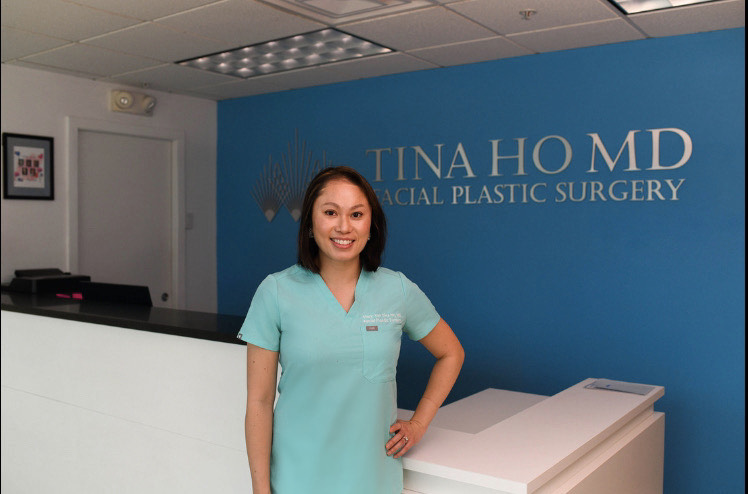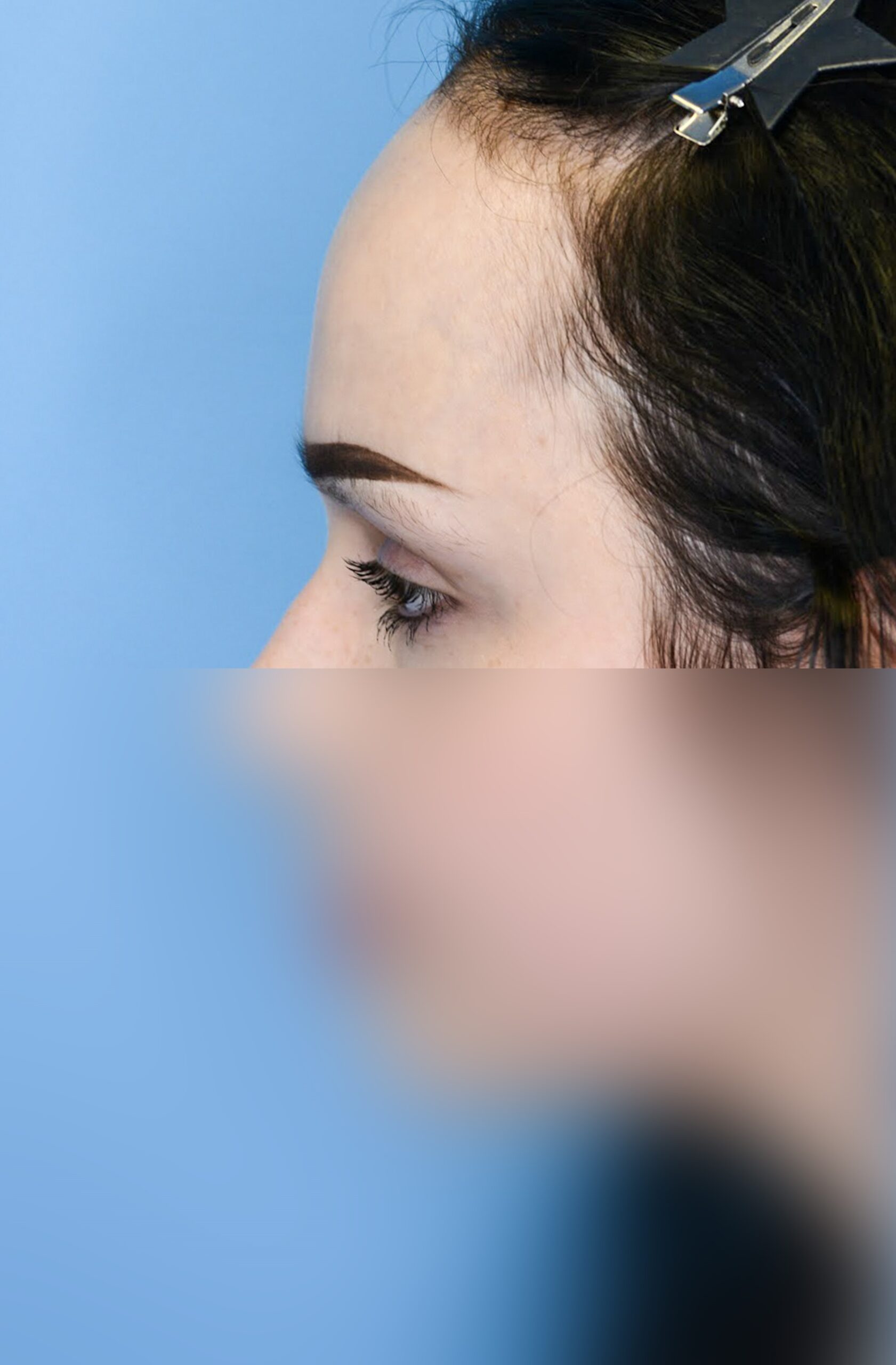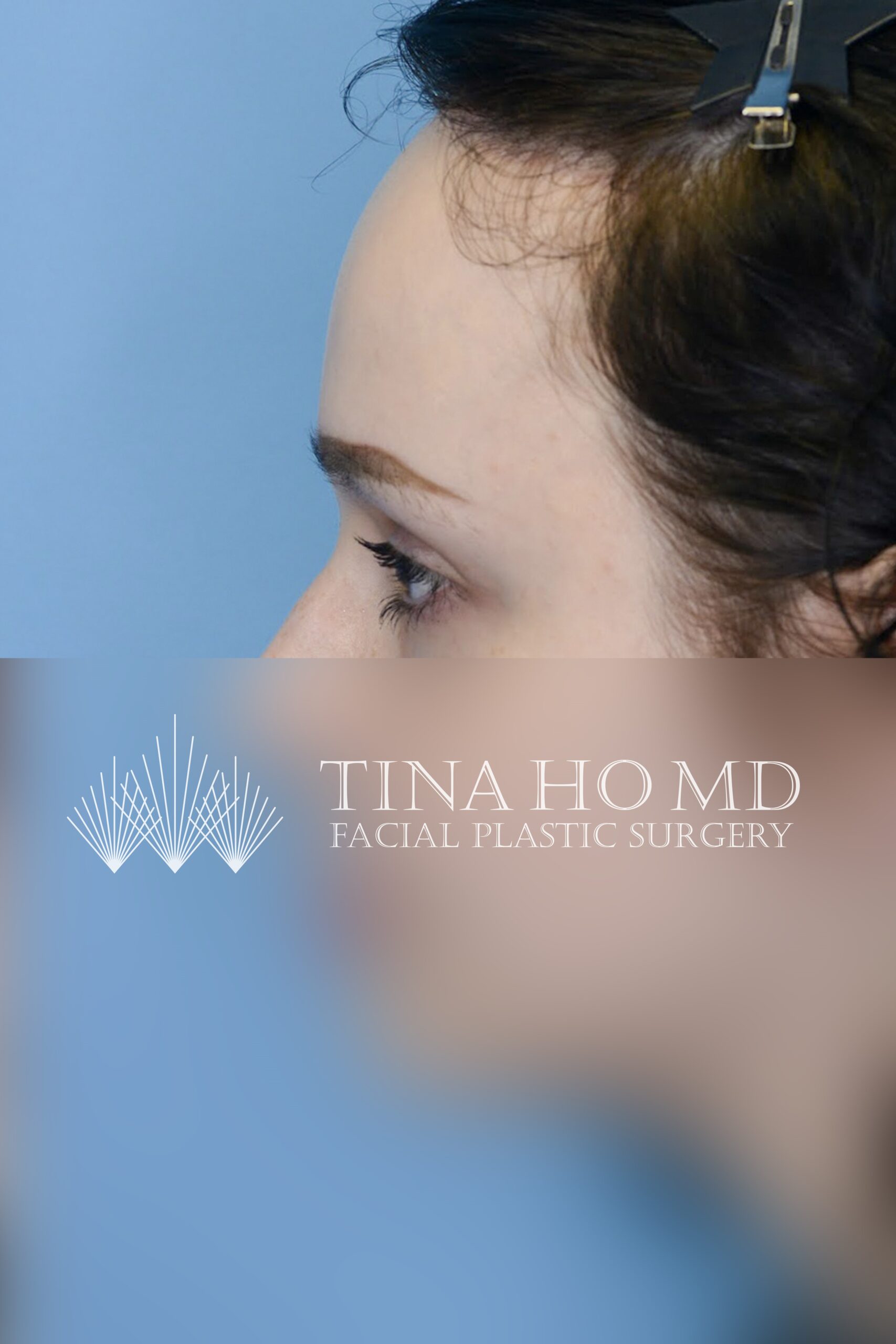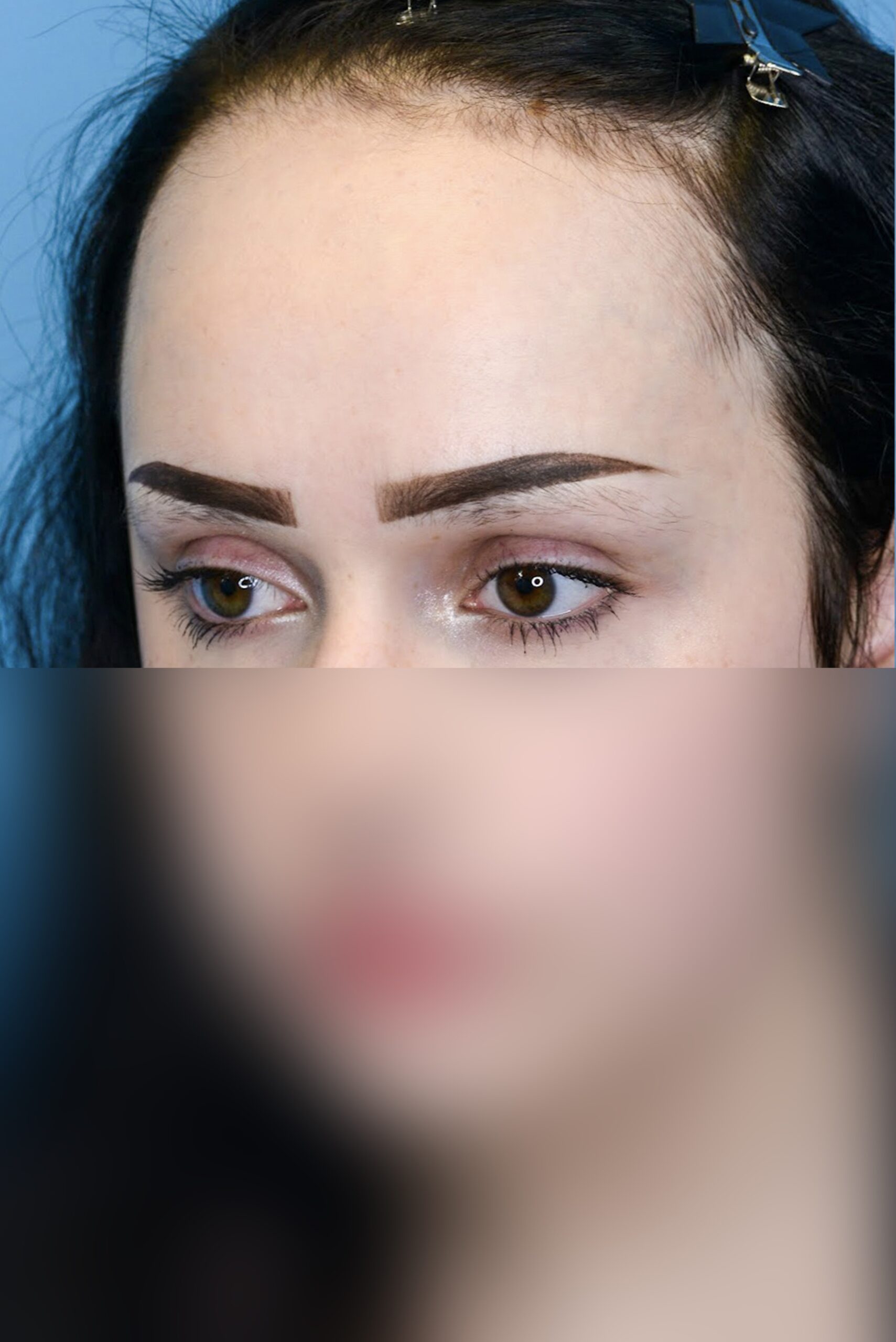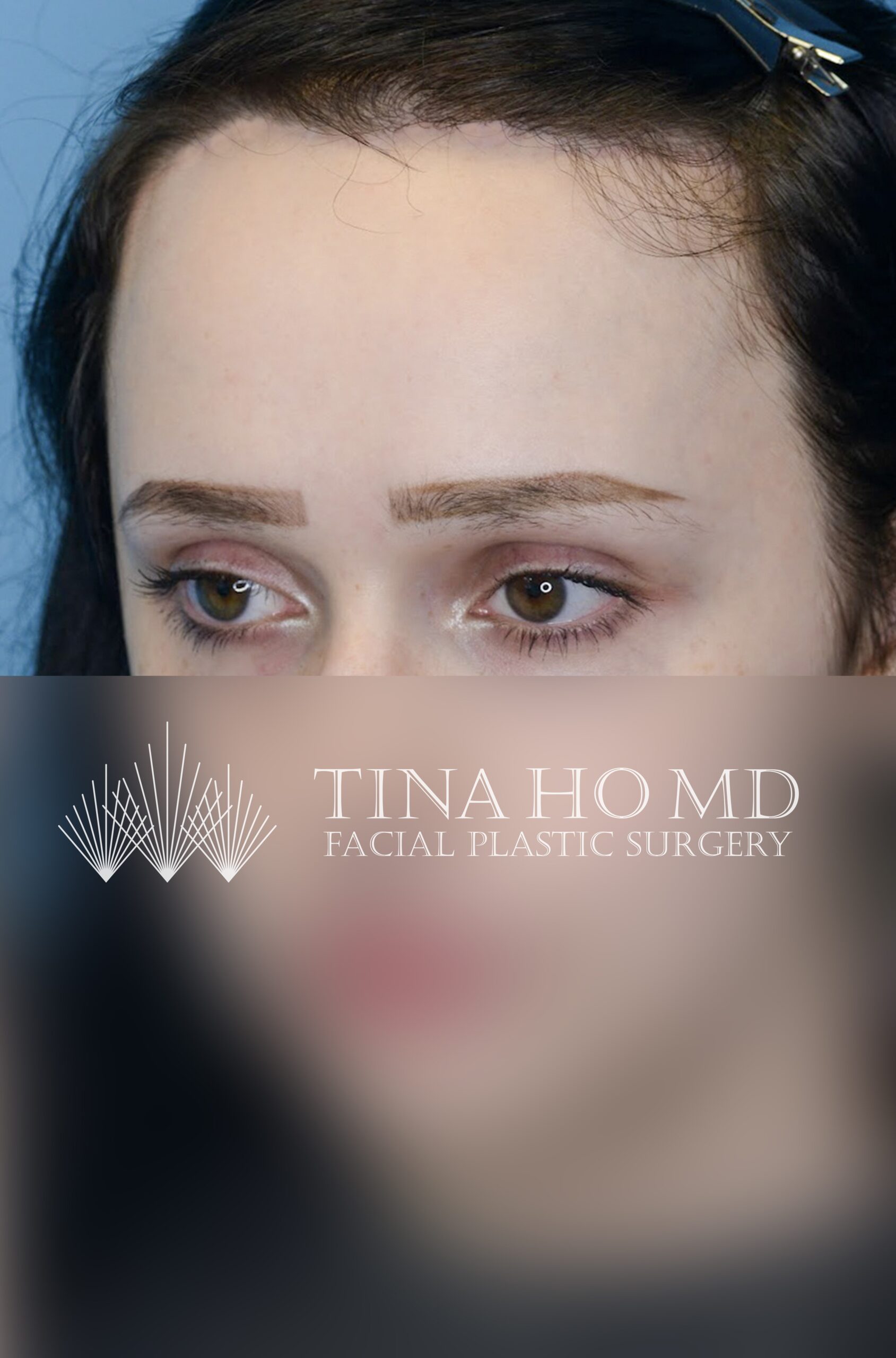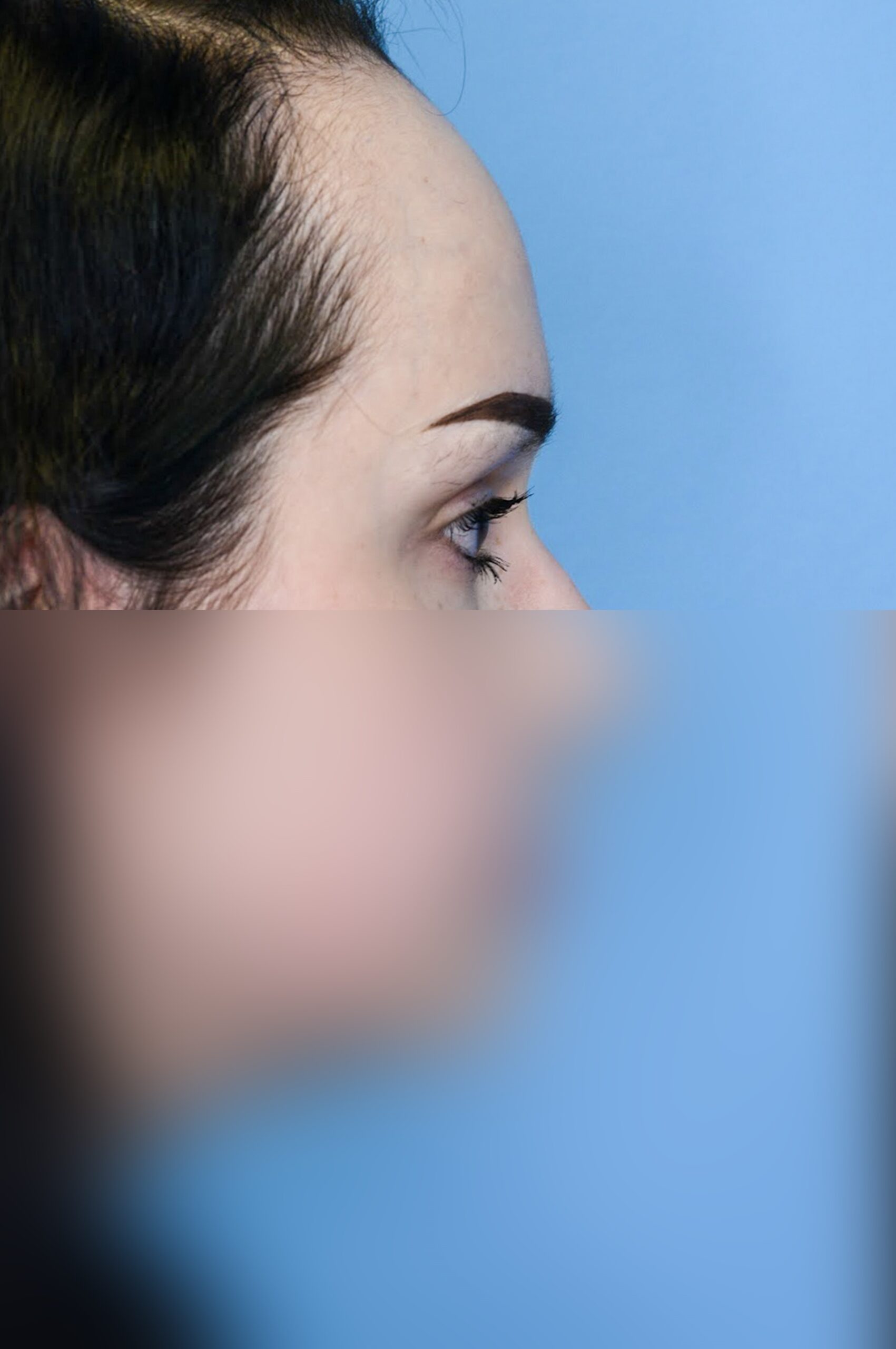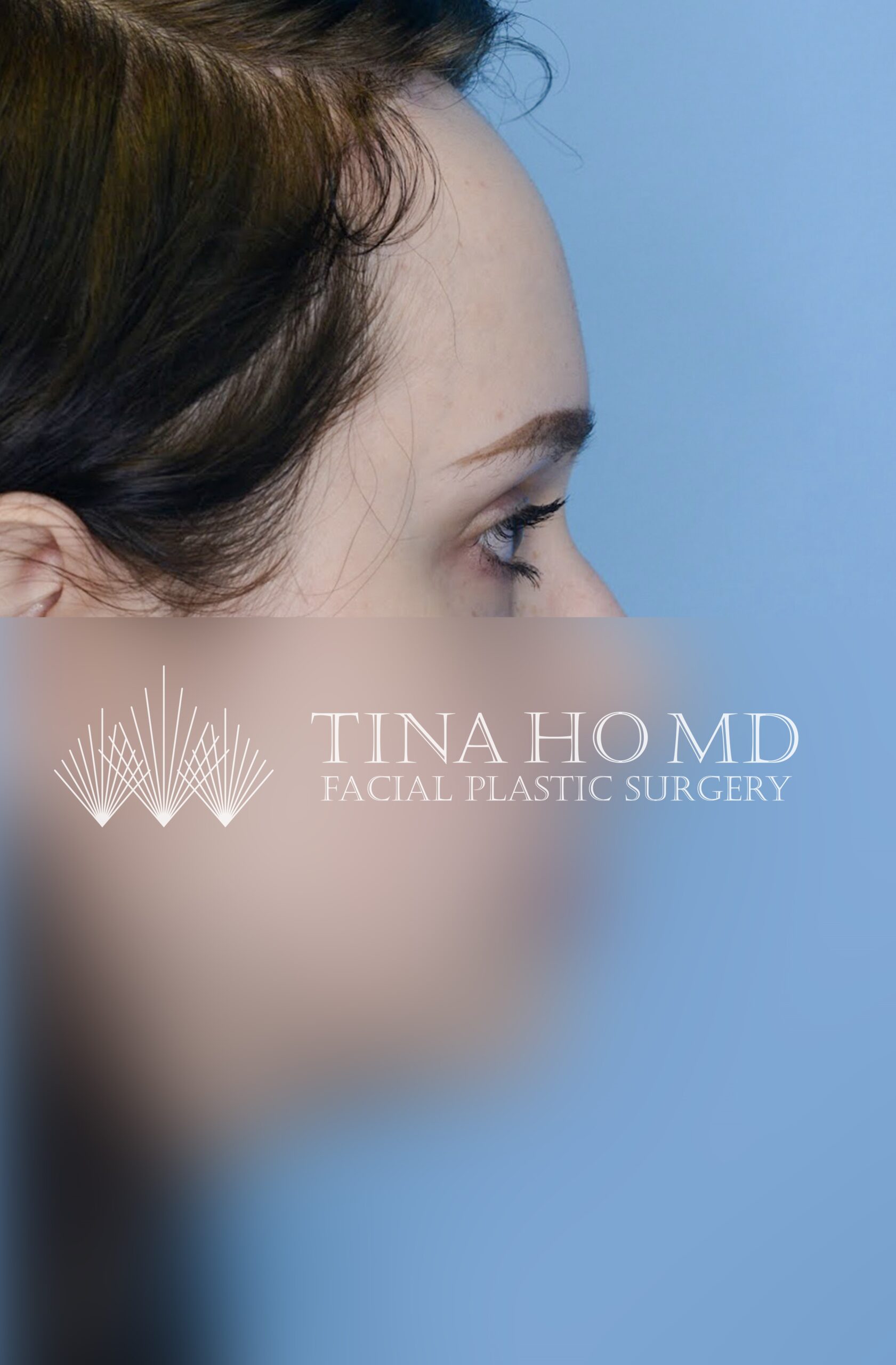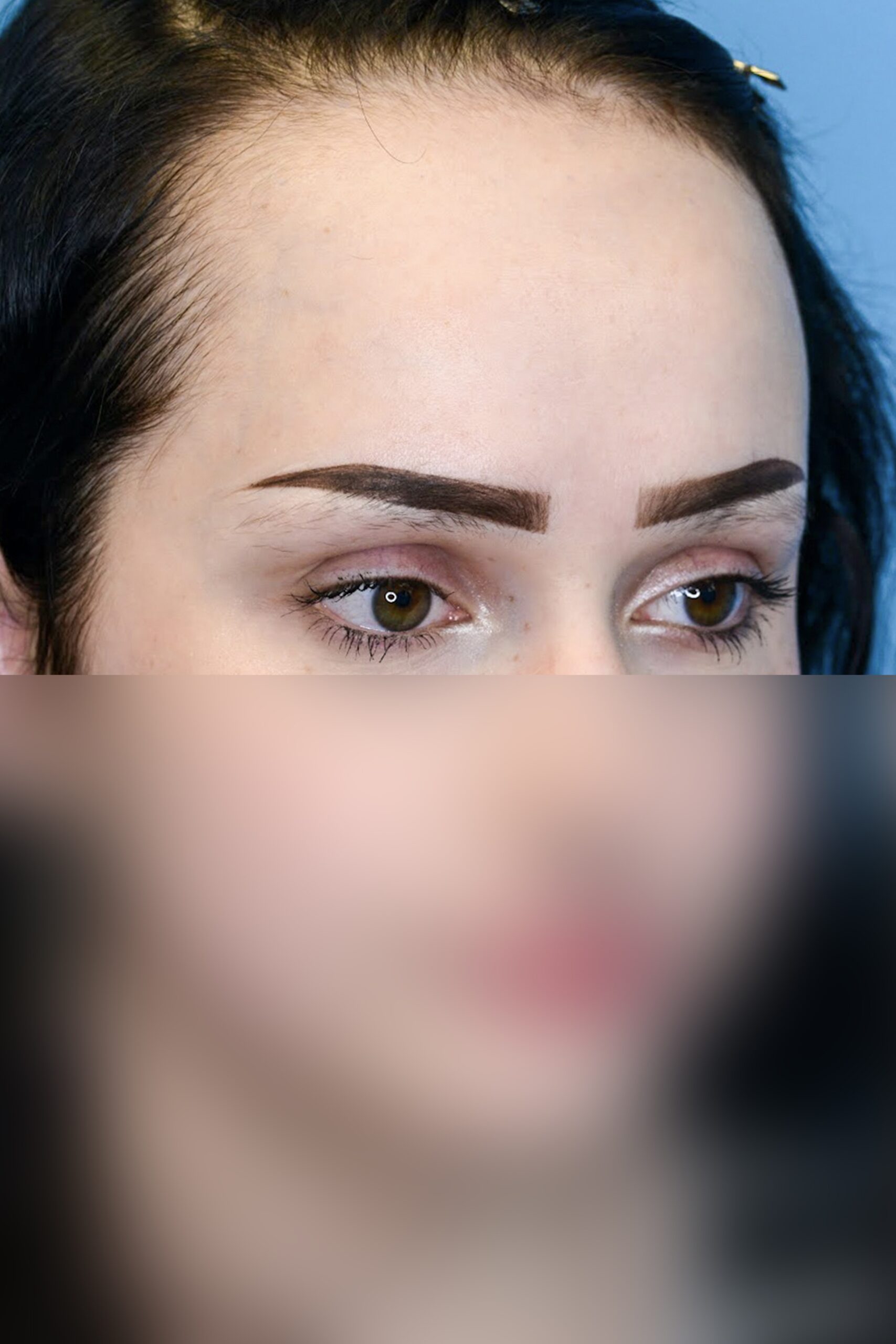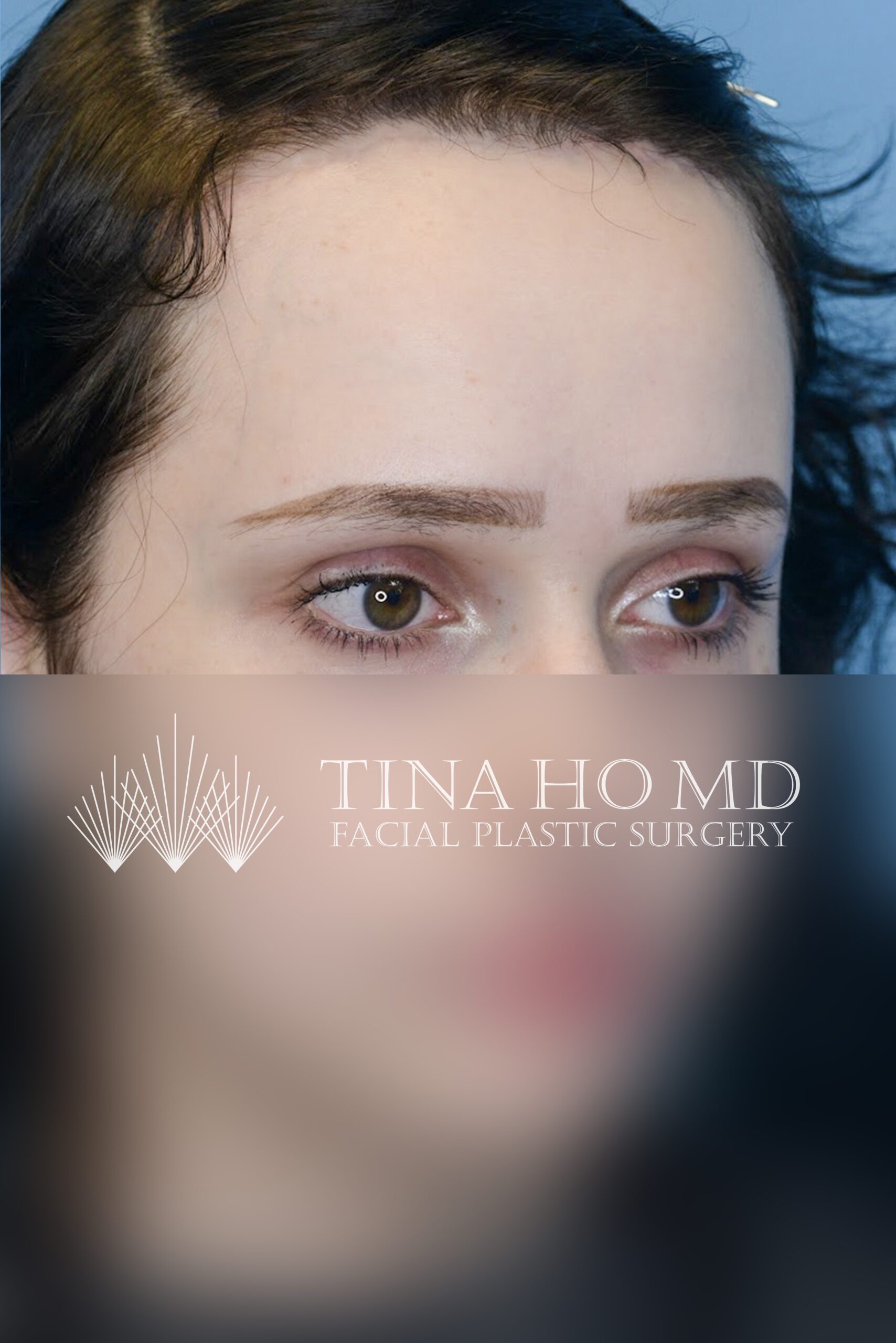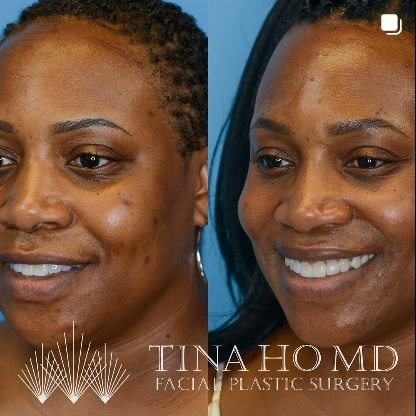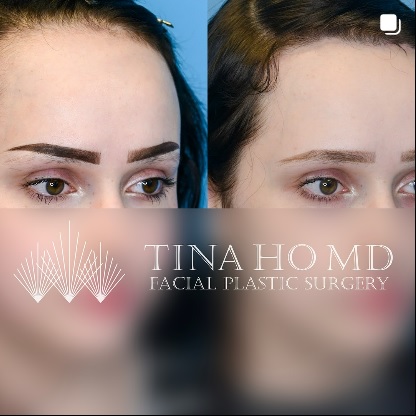Table of Contents
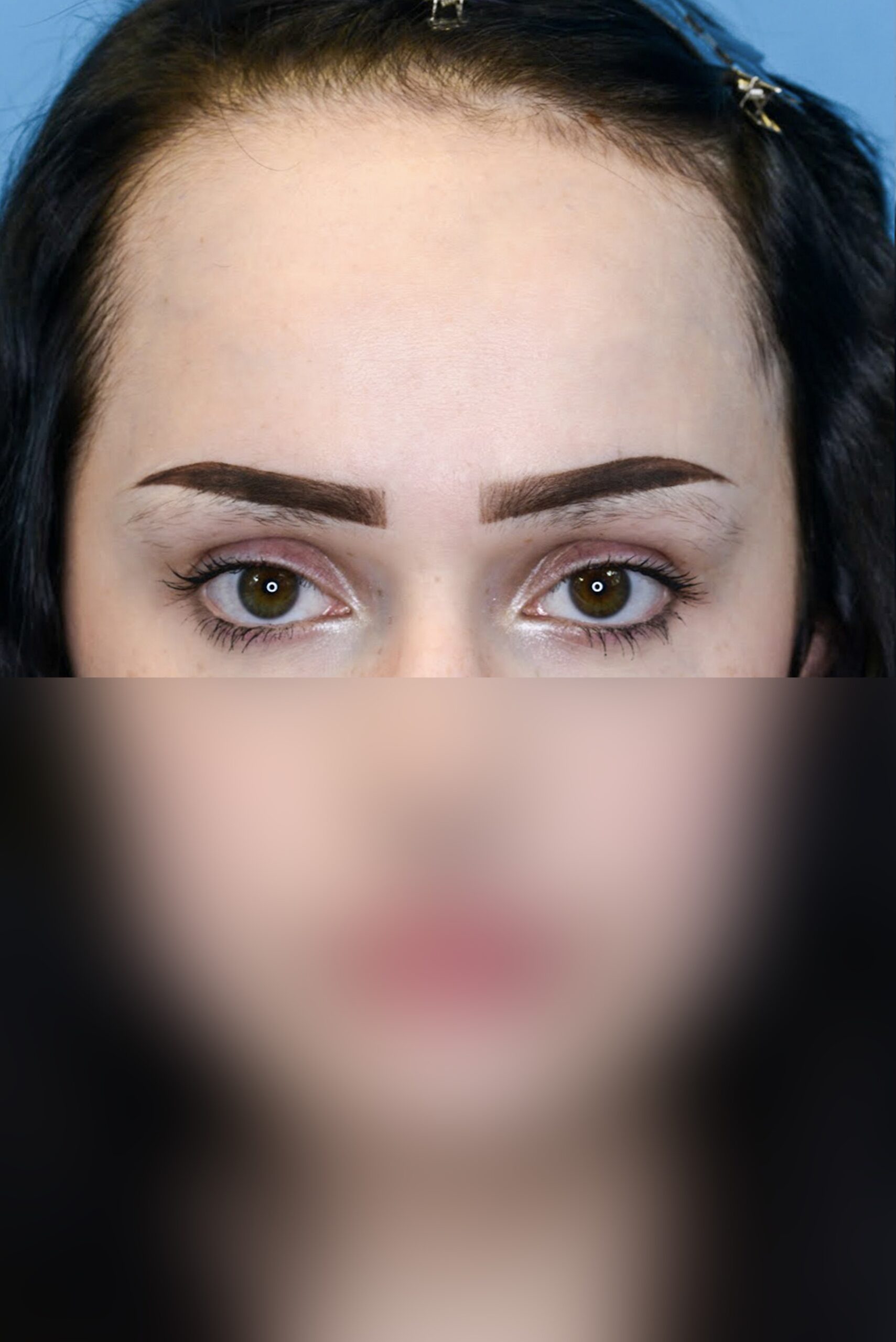
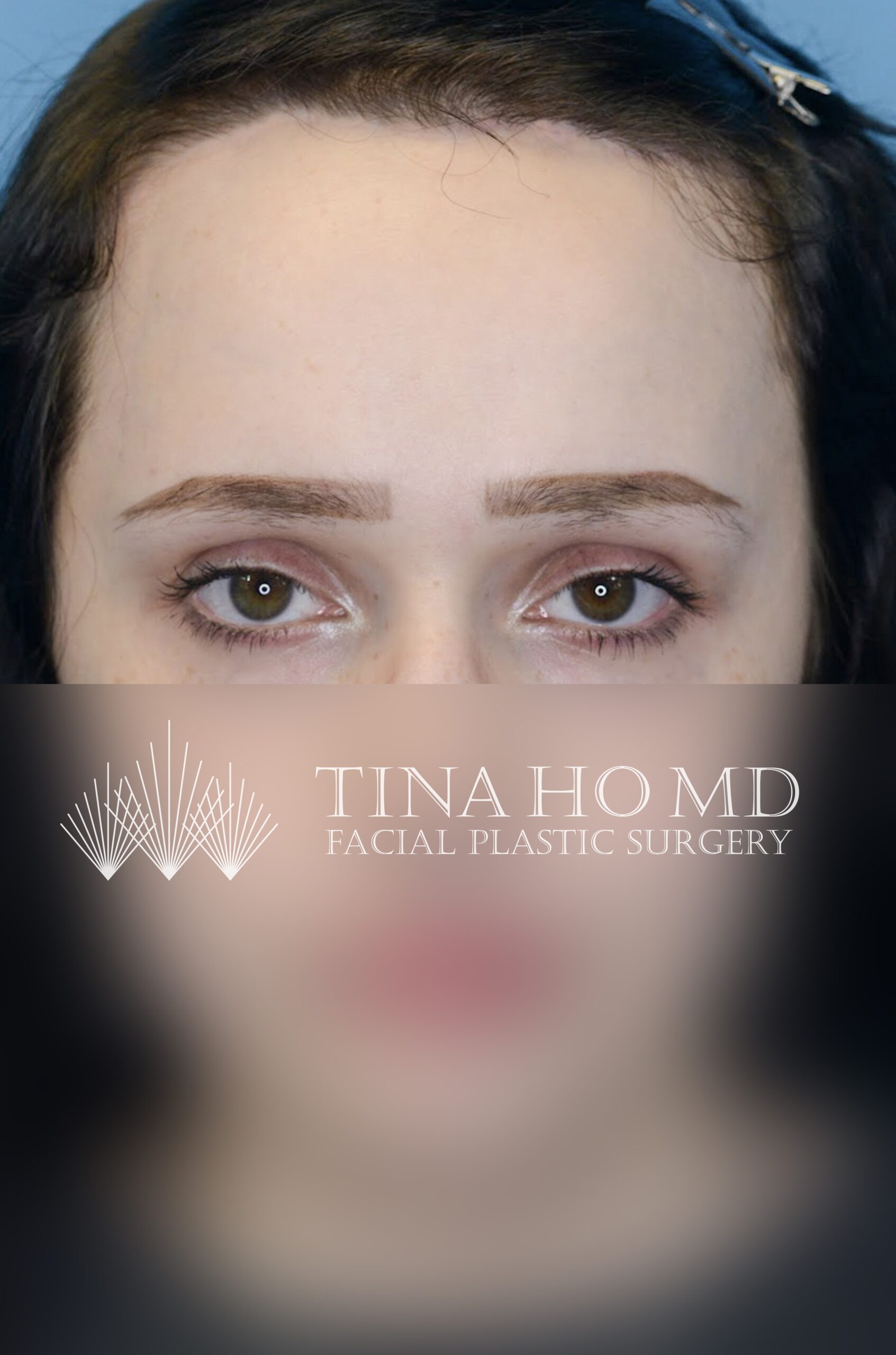
Before & After
View Gallery
What is Forehead Reduction Surgery?
Forehead reduction surgery is a cosmetic procedure designed to reduce the size of a disproportionately large forehead. The length of one’s forehead can differ significantly from person to person. Some individuals are born with larger foreheads, but in others, the size of their forehead may increase due to a receding hairline.
Whether present from birth or acquired through hair loss, hairline lowering surgeries (forehead reduction surgeries) advance the hairline forward to reduce the overall size of the forehead. In addition, excess skin is removed. Relative eyebrow position is changed but not raised.
Hairline lowering in Philadelphia aims to create a naturally looking, aesthetically pleasing appearance of the face by improving the overall proportions of facial features. A forehead reduction can be combined with a brow lift surgery to enhance the correction of facial proportions.
Benefits of Forehead Reduction Surgery
An overly large forehead can distract from other facial features and create a disproportional facial balance. An expert forehead reduction surgeon uses advanced techniques to address these issues improving the aesthetic appearance of the face. Benefits associated with a forehead reduction surgery include:
- Reduction in forehead size to better harmonize with other facial features.
- Restoration of a more youthful appearing hairline.
- A natural, aesthetically pleasing appearance of the face.
- A more symmetric, balanced appearance to the facial features.
- A boost to one’s self-confidence and self-esteem.
- Minimal recovery time is needed before returning to normal activities.
Overall, forehead reduction surgery is an effective cosmetic procedure that provides patients the opportunity to achieve a more desirable facial appearance and restores any lost confidence by creating a more aesthetically pleasing appearance. This procedure helps to highlight the natural beauty of your facial features.
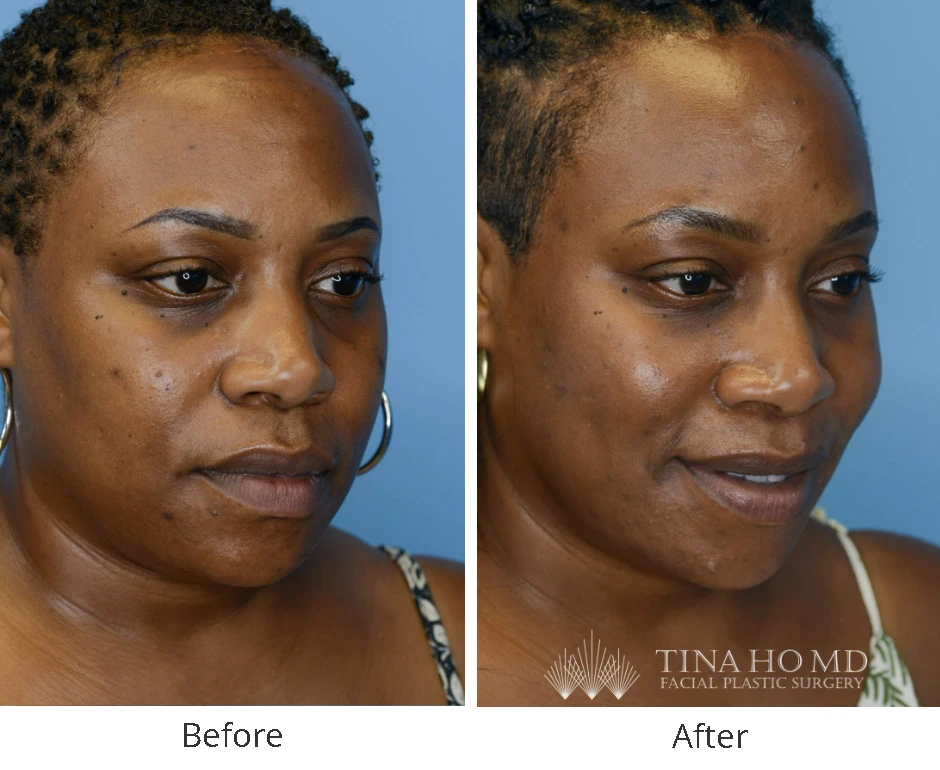
Candidates for Forehead Reduction Surgery
In Philadelphia, hairline lowering surgery is ideal for individuals born with a high forehead and who have no appreciable hair loss. This situation is more commonly encountered in women, but men can also present with this combination.
To be a candidate for forehead reduction surgery, the laxity of the scalp and forehead skin must be determined. The skin of the scalp must be elastic enough to be ideally advanced 20 mm, but this procedure can still be performed in patients with as little as only 16 mm of advancement.
An ideal candidate should be in good physical and mental health to help reduce the chance of complications. Candidates should be non-smokers and have realistic expectations of what this procedure can accomplish to maximize the chances of a successful outcome.
Have questions about whether you are a good candidate? As a forehead reduction specialist in Philadelphia, Dr. Tina Ho can perform an evaluation and answer any questions during your consultation. If you are not a good candidate, Dr. Ho can suggest other options to help you achieve your desired results.
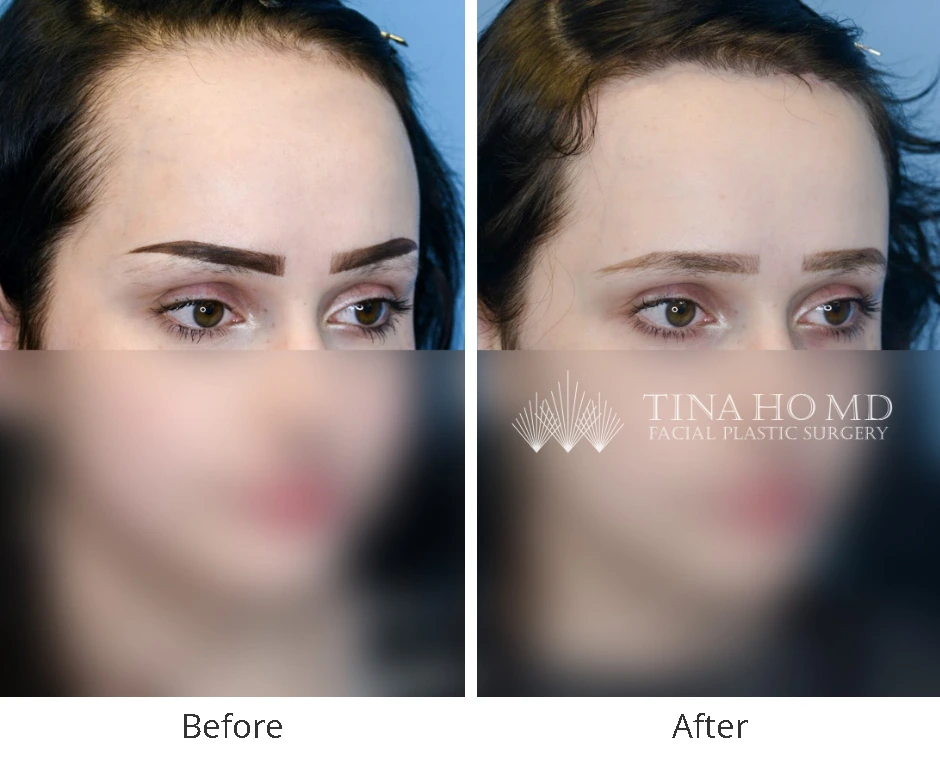
What is Ideal Hairline Anatomy?
In a female patient, the ideal hairline height is about 5 to 6 cm from the medial brows. The hairline typically slopes from horizontal in the middle to vertical laterally. Hairlines greatly vary by patient as well as the treatment goals of forehead reduction patients. The most common cause of a high hairline is heredity.
FOREHEAD REDUCTION BEFORE & AFTER PHOTOS
Preparing for Forehead/Hairline Reduction Surgery
Preparing for forehead reduction surgery is important to prevent complications and to ensure the best possible outcome — recommended steps for preparing for surgery:
- Avoid certain medications. Aspirin, ibuprofen, and other anti-inflammatories can increase the risk of bleeding and should be avoided for at least one week before surgery.
- Abstain from alcohol. Alcohol can thin the blood and should be avoided at least tone week before surgery.
- Follow medication recommendations. Dr. Ho or your primary care doctor may have provided recommendations regarding your chronic medications, and it is important to follow these to reduce complications.
- Avoid smoking and vaping. To maximize healing, smoking should be avoided for a minimum of 2 months before surgery.
- Wash face and hair. Before surgery, wash your face and hair thoroughly, and do not put creams or makeup on your face or hair on the day of surgery.
- Arrange for help post-operatively. Talk with a family member or friend to ensure you have plenty of help after surgery as you heal.
Recovery and Post-Operative Care
After surgery, bruising, swelling, and mild discomfort are commonly experienced by patients. Pain medications may be needed initially after surgery but they typically will not be required for more than a few days to a week out. The bruising will begin dissipating at approximately one week, but the swelling will require additional time to resolve. Sleeping with the head elevated will help minimize swelling and aid healing.
Most patients will require a week or two to recover from the procedure. You may return to work when comfortable, typically around 7 to 14 days after surgery. Normal activities can be resumed two weeks following surgery to ensure sufficient healing.
The incision will fully heal and the scar will start to fade and become less noticeable around six months. It will take at least six to twelve months for the scars to reach their final state. However, prior to this, many patients elect to cover the incision using hats, headbands, and hairstyles. After a couple of months, your hair will begin to grow through the incision, further hiding the scar. Any numbness along the incision should resolve over four to six months. The final results of the surgery will be visible at 6 to 12 months postoperatively.
To ensure proper healing it is important to follow all post-operative directions provided by Dr. Tina Ho. Avoiding excessive sun exposure and using sunscreens as well as applying a silicone gel are important in achieving the best results in scar healing.
Average Cost of Forehead Reduction Surgery
Forehead reduction in Philadelphia costs can range from $9,000 to $11,000. This price range has a wide gap because multiple factors must be considered when determining the overall costs. Dr. Ho will evaluate your individualized needs and desires to produce a customized plan and provide you with a detailed total cost of the procedure so that you can fully understand the investment required.
Factors Determining the Cost of Forehead Reduction
The total cost of hairline lowering in Philadelphia is affected by the need for additional procedures, geographic location, surgeon experience, and fees associated with surgical assistants and support staff.
Additional Procedures
The goal of forehead reduction surgery is to improve the proportions of facial features and can require additional procedures to maximize this goal. Performing an eyebrow lift or eyelid surgery is commonly utilized in conjunction with this procedure for a more dramatic improvement.
When additional procedures are added to the surgery, this will ultimately raise the overall costs but can help maximize the transformative potential of the surgery.
Geographic Location
The demand for forehead reduction procedures varies depending on the location where one is seeking treatment. Large cities, such as Philadelphia, have much higher demands for this procedure as well as higher costs of operating, which results in higher procedural pricing. This trend is also seen in cities along the East and West Coast, where the demand for cosmetic procedures is higher.
Surgeon’s Experience
The surgeon’s experience is arguably the most important factor in deciding to undergo a forehead reduction surgery. This experience is beneficial in identifying additional procedures to maximize the results and reducing the number of complications. Selecting a surgeon experienced in forehead reduction surgery is invaluable, and can prevent the need for revision procedures to fix poorly done procedures.
The higher demand for an experienced hairline-lowering specialist in Philadelphia will result in higher prices. However, the increased upfront costs can pay dividends if complications and revision surgeries are avoided.
Surgical and Support Staff Fees
Forehead reduction surgeries are performed under local sedation or general anesthesia at an ambulatory surgery center or a hospital. Therefore, additional facility fees, anesthesia fees, and support staff fees will need to be factored into the total cost of the procedure and will be included in the detailed description of the procedure’s cost.
Are Financing Options Available?
Yes. Tina Ho MD Facial Plastic Surgery provides options that allow you to pay for the procedure over time. Our practice participates with CareCredit. These options will be discussed during the initial consultation so that you are aware of all your choices before choosing to proceed with a forehead reduction. However, ensuring this procedure makes financial sense for your situation is essential.
Why Choose Dr. Tina Ho
Dr. Tina Ho is a double board-certified facial plastic surgeon and an expert forehead reduction surgeon. As a female surgeon, she is intuitively aware of the concerns and needs of her patients and provides a relaxed environment to discuss available cosmetic options.
Identified as the best in cosmetic surgery by Philadelphia Style Magazine, Dr. Ho provides world-class care for the Philadelphia area and surrounding communities and states. Priding herself on providing her patients with individualized care and exceptional treatment, Dr. Ho has established herself as one of the best forehead reduction surgeons in Philadelphia.
Dr. Ho’s office is conveniently located to serve Philadelphia and the surrounding metropolitan region and the greater tri-state area including Center City, the Main Line, Montgomery County, Chester County, Delaware County, New Jersey, New York, and Delaware.
Schedule a Consultation at Tina Ho MD Facial Plastic Surgery
If you are unhappy with the appearance of your forehead and feel it distracts from your other facial features, Dr. Ho can help restore the beauty and symmetry of the face with a forehead reduction procedure. Boost your confidence today, schedule a consultation at Tina Ho MD Facial Plastic Surgery, where you will receive extraordinary care with a personalized approach to achieve the best results possible.
To schedule a consultation, call our office at 267-578-3064 (Philadelphia) or 610-688-3363 (Wayne).
Book Now
– Dr. Tina Ho

FAQ’s
How painful is forehead reduction?
Forehead reduction surgery, also known as hairline lowering surgery, is a cosmetic procedure that involves lowering the hairline to reduce the size of the forehead. The procedure involves manipulation of soft tissues only, resulting in mild-to-moderate soreness for patients after surgery and it is rare for patients to have any significant pain. Patients may be provided pain medication as needed but it is rare to require more than a couple days to a week of medication.
How much does forehead reduction reduce?
The amount of reduction a hairline-lowering surgery can obtain depends on the laxity of the patient’s scalp. Typically surgeons are able to achieve a reduction of 0.6 inches (1.6 centimeters) to 1.2 inches (3 centimeters). This procedure will also remove excess skin from the forehead which has the possibility of altering the position of the eyebrows.
Does forehead reduction surgery look natural?
Yes, forehead reduction surgery can produce incredibly natural-looking results when performed by an experienced surgeon. Correct placement of the incision results in it typically being hard to see, even in thinner hair with thicker hair hiding it better. For many people, the incision is hidden making it difficult for others to tell if you have had surgery. Additional procedures can further enhance the harmony of facial features to give a naturally, aesthetically pleasing appearance.
How long does hairline lowering surgery take to heal?
The swelling, bruising, and discomfort of the procedure will typically begin resolving around one to two weeks after the procedure. The majority of healing will be complete at around three to six months post-surgery. However, it is typically recommended that the final results of a forehead reduction should not be judged until six to twelve months after the procedure. This will ensure full healing from the procedure and resolution of swelling from the surgery.
What is the best age to get hairline surgery?
The ideal candidate for a forehead reduction surgery is an individual with a high forehead, thinning hair, or an asymmetric hairline and possesses scalp mobility. Depending on genetics, facial aging, and the extent of hairline recession the best age to have this procedure performed can vary significantly. Hairline-lowering surgeries have been performed in patients ranging from 18 to 65 years of age.
While there is no ideal age to undergo a forehead reduction, most patients are in their 20s to 30s when they undergo this procedure. Expert forehead reduction surgeons do recommend patients wait until they are at least 18 to undergo the procedure to allow the face to fully mature.
What are alternatives to forehead reduction?
Alternative treatment options to forehead reduction include observation (no treatment), non-surgical hair loss therapies including oral supplements, PRP injections, exosomes, and microneedling, and hair transplantation. If forehead reduction can only achieve a conservative result based on the patient’s anatomy, it may be combined with hair transplantation to create more hairline lowering or to better camouflage the scar.
Book Now

